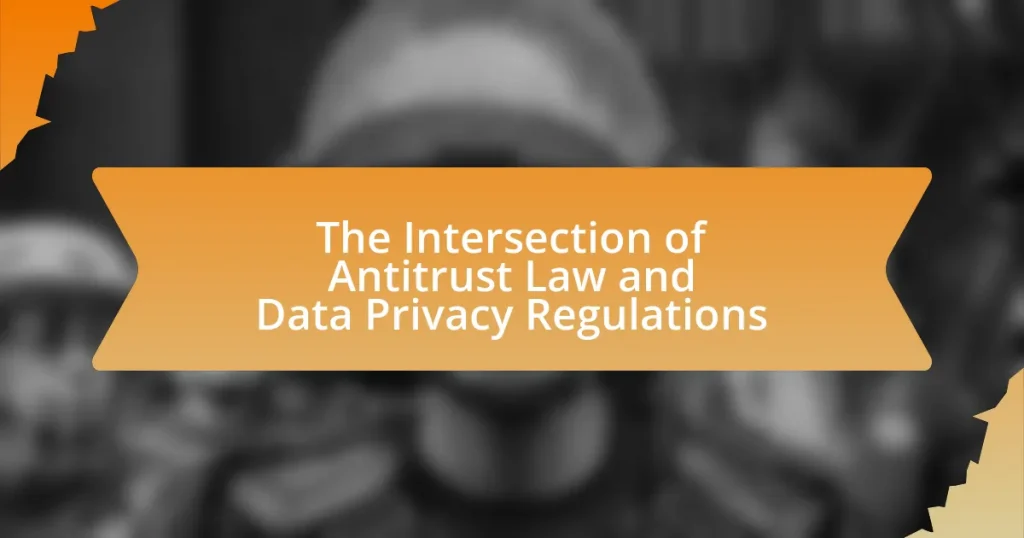The article focuses on recent developments in antitrust case law, particularly highlighting key rulings from the Supreme Court that have clarified legal standards for antitrust claims. Significant cases such as “Facebook, Inc. v. Duguid” and “NCAA v. Alston” illustrate the evolving interpretation of antitrust laws, emphasizing the need for a rigorous analysis of market power and consumer harm. The article discusses how these rulings impact businesses, the risks they face, and the strategies they can adopt to navigate the changing antitrust landscape. Additionally, it examines the implications of these legal principles for future litigation and the role of public opinion in shaping antitrust enforcement.

What are the Recent Developments in Antitrust Case Law?
Recent developments in antitrust case law include significant rulings by the Supreme Court that have clarified the standards for antitrust claims. For instance, in 2021, the Supreme Court ruled in the case of “Facebook, Inc. v. Duguid,” which addressed the definition of an “automatic telephone dialing system” under the Telephone Consumer Protection Act, impacting how antitrust laws intersect with technology and consumer protection. Additionally, the Court’s decision in “NCAA v. Alston” in 2021 established that the NCAA’s restrictions on education-related benefits for student-athletes violated antitrust laws, emphasizing that antitrust scrutiny applies to non-profit organizations as well. These rulings reflect a trend towards a more rigorous application of antitrust principles in various sectors, particularly in technology and sports.
How have recent Supreme Court rulings impacted antitrust regulations?
Recent Supreme Court rulings have significantly impacted antitrust regulations by narrowing the scope of legal standards for proving antitrust violations. For instance, the 2021 ruling in the case of “Facebook, Inc. v. Duguid” clarified that plaintiffs must demonstrate a specific intent to harm competition, which raises the bar for antitrust claims. Additionally, the Court’s decision in “Ohio v. American Express Co.” reinforced the need for a more rigorous analysis of market power and consumer harm, emphasizing that antitrust enforcement should focus on protecting competition rather than individual competitors. These rulings collectively shift the landscape of antitrust law, making it more challenging for plaintiffs to succeed in antitrust litigation.
What specific cases have been influential in shaping current antitrust law?
The specific cases that have been influential in shaping current antitrust law include United States v. Standard Oil Co. (1911), which established the “rule of reason” standard for evaluating monopolistic practices, and United States v. Microsoft Corp. (2001), which addressed anti-competitive behavior in the software market. The ruling in Standard Oil set a precedent for assessing whether a company’s conduct unreasonably restrains trade, while the Microsoft case highlighted the importance of maintaining competition in rapidly evolving industries. These cases have significantly influenced the interpretation and enforcement of antitrust laws in the United States.
How do these rulings reflect changes in economic and market conditions?
Recent rulings in antitrust case law reflect significant changes in economic and market conditions by adapting legal interpretations to contemporary market dynamics. For instance, the Supreme Court’s decision in cases like Ohio v. American Express highlighted the importance of market power and consumer choice in a digital economy, indicating a shift towards recognizing the complexities of multi-sided markets. This ruling aligns with the increasing prevalence of technology-driven platforms, which have transformed traditional market structures and consumer interactions. Additionally, the Court’s emphasis on economic evidence in assessing anti-competitive behavior demonstrates a response to evolving market practices, where data and digital services play a crucial role in competition. These rulings illustrate a legal framework that is increasingly responsive to the realities of modern economic environments, ensuring that antitrust laws remain relevant and effective in promoting fair competition.
Why is understanding these developments important for businesses?
Understanding recent developments in antitrust case law is crucial for businesses because these rulings directly impact competitive practices and regulatory compliance. For instance, the Supreme Court’s decisions can redefine market boundaries, influence merger approvals, and alter pricing strategies. Businesses that stay informed about these legal changes can better navigate potential risks, avoid costly litigation, and adapt their strategies to align with current legal standards, ultimately safeguarding their market position and ensuring long-term sustainability.
What risks do businesses face in light of recent antitrust rulings?
Businesses face significant risks in light of recent antitrust rulings, including increased scrutiny from regulatory bodies, potential for hefty fines, and the threat of litigation. These rulings have led to a more aggressive enforcement environment, where companies may be compelled to alter their business practices to avoid violations. For instance, the Supreme Court’s decision in cases like Ohio v. American Express has emphasized the importance of market competition, prompting businesses to reassess their pricing strategies and contractual agreements. Additionally, the potential for class-action lawsuits has risen, as consumers and competitors may seek damages for perceived anti-competitive behavior, further exposing businesses to financial and reputational risks.
How can businesses adapt to the evolving antitrust landscape?
Businesses can adapt to the evolving antitrust landscape by proactively reviewing and adjusting their compliance strategies to align with recent legal interpretations and rulings. This includes conducting regular audits of business practices to ensure they do not inadvertently violate antitrust laws, especially in light of the Supreme Court’s recent decisions that may broaden the scope of antitrust scrutiny. For instance, the Supreme Court’s ruling in cases like Ohio v. American Express has emphasized the importance of market definition and the balancing of competitive effects, prompting businesses to reassess their market positions and competitive strategies. By staying informed about these developments and engaging legal counsel for guidance, businesses can better navigate the complexities of antitrust regulations and mitigate potential legal risks.

What are the Key Rulings from the Supreme Court in Antitrust Cases?
The key rulings from the Supreme Court in antitrust cases include several landmark decisions that have shaped antitrust law in the United States. Notable cases include “United States v. Microsoft Corp.” (2001), where the Court upheld the government’s position that Microsoft engaged in anti-competitive practices by bundling its software products, leading to a significant settlement that imposed restrictions on Microsoft’s business practices. Another important ruling is “Leegin Creative Leather Products, Inc. v. PSKS, Inc.” (2007), which established that minimum resale price maintenance agreements are not automatically illegal under antitrust law, allowing for more flexibility in pricing strategies. Additionally, “American Express Co. v. Italian Colors Restaurant” (2013) reinforced the enforceability of arbitration clauses in contracts, impacting how businesses can resolve disputes related to antitrust claims. These rulings collectively illustrate the evolving interpretation of antitrust laws by the Supreme Court, influencing both enforcement and business practices in the marketplace.
Which Supreme Court cases have set significant precedents in antitrust law?
Significant Supreme Court cases that have set precedents in antitrust law include the Sherman Antitrust Act cases, particularly Standard Oil Co. v. United States (1911), which established the “rule of reason” for determining whether a business practice is anti-competitive. Another key case is United States v. Microsoft Corp. (2001), which addressed monopolistic practices and defined the scope of antitrust enforcement in the technology sector. Additionally, the case of Leegin Creative Leather Products, Inc. v. PSKS, Inc. (2007) overturned the per se rule against minimum resale price maintenance, allowing for a more flexible approach to evaluating such agreements under antitrust law. These cases collectively shape the legal framework governing competition and market practices in the United States.
What were the outcomes of these key cases?
The outcomes of key antitrust cases from the Supreme Court have significantly shaped competition law in the United States. For instance, in the case of Ohio v. American Express Co., the Court ruled that American Express’s anti-steering provisions did not violate antitrust laws, emphasizing the importance of market definition and the need to consider the effects on both sides of a two-sided market. In another pivotal case, FTC v. Qualcomm Inc., the Court upheld Qualcomm’s licensing practices, determining that they did not constitute anti-competitive behavior, thereby reinforcing the legality of certain business practices in technology markets. These rulings illustrate the Court’s approach to balancing competition with business practices, impacting how antitrust laws are interpreted and enforced.
How have these outcomes influenced lower court decisions?
Recent Supreme Court rulings in antitrust case law have significantly influenced lower court decisions by establishing clearer legal standards and precedents. For instance, the Supreme Court’s decision in Ohio v. American Express clarified the application of the rule of reason in antitrust analysis, prompting lower courts to adopt a more rigorous approach when evaluating market power and anti-competitive practices. This shift has led to a more consistent application of antitrust principles across various jurisdictions, as lower courts reference these rulings to guide their interpretations and rulings in similar cases.
What legal principles have emerged from these rulings?
Recent rulings from the Supreme Court have established several key legal principles in antitrust case law. One significant principle is the emphasis on the “rule of reason” standard, which requires a comprehensive analysis of a company’s conduct and its effects on competition rather than a blanket prohibition of certain practices. Additionally, the Court has reinforced the importance of market definition, asserting that accurate delineation of relevant markets is crucial for assessing competitive effects. These principles are supported by cases such as Ohio v. American Express Co., where the Court highlighted the necessity of considering both sides of a market in antitrust evaluations, demonstrating a nuanced approach to competition analysis.
How do these principles affect the interpretation of antitrust laws?
The principles of economic efficiency and consumer welfare significantly shape the interpretation of antitrust laws. These principles guide courts and regulators in assessing whether business practices promote competition or harm consumers. For instance, the Supreme Court’s ruling in the 2007 case of Leegin Creative Leather Products, Inc. v. PSKS, Inc. emphasized that vertical price restraints could be lawful if they enhance competition and benefit consumers, reflecting a shift towards a more nuanced understanding of market dynamics. This approach aligns with the consumer welfare standard, which prioritizes the effects of business conduct on consumer prices and choices, thereby influencing how antitrust laws are applied in various cases.
What implications do these principles have for future litigation?
The principles established in recent Supreme Court rulings on antitrust case law will significantly influence future litigation by setting clearer standards for evaluating anti-competitive behavior. These rulings, such as the decision in Ohio v. American Express, emphasize the importance of market definition and the need for plaintiffs to demonstrate actual harm to competition rather than merely alleging potential harm. This shift requires future litigants to present more robust economic evidence and analysis to support their claims, thereby raising the bar for successful antitrust litigation. Additionally, the focus on consumer welfare as a primary consideration in these rulings will likely steer future cases toward evaluating the effects of business practices on consumer prices and choices, further shaping the landscape of antitrust enforcement.

How do Recent Developments Affect Future Antitrust Litigation?
Recent developments in antitrust case law, particularly key rulings from the Supreme Court, significantly shape future antitrust litigation by establishing new legal precedents and clarifying existing standards. For instance, the Supreme Court’s decision in cases like Ohio v. American Express has reinforced the importance of market definition and the burden of proof in antitrust claims, which will likely influence how future cases are argued and adjudicated. Additionally, the Court’s approach to evaluating anti-competitive behavior, as seen in the ruling on the legality of certain business practices, sets a framework that lower courts will follow, thereby impacting the strategies employed by both plaintiffs and defendants in upcoming litigation.
What trends can be observed in antitrust litigation following recent rulings?
Recent rulings in antitrust litigation indicate a trend towards increased scrutiny of mergers and acquisitions, particularly in technology sectors. Courts are now more likely to challenge proposed consolidations that may harm competition, as evidenced by the Federal Trade Commission’s successful block of the merger between Meta and Within in 2022. Additionally, there is a growing emphasis on the consumer welfare standard, with courts reinforcing that antitrust laws should prioritize consumer interests over corporate efficiencies. This shift is reflected in the Supreme Court’s decision in the case of Ohio v. American Express, which underscored the importance of evaluating market power in the context of consumer choice. These trends suggest a more aggressive approach to enforcing antitrust laws, aiming to prevent anti-competitive practices and promote market fairness.
How are plaintiffs and defendants adjusting their strategies in light of these trends?
Plaintiffs and defendants are adjusting their strategies by closely analyzing recent Supreme Court rulings to refine their legal arguments and evidence presentation. Plaintiffs are increasingly focusing on demonstrating direct consumer harm and market impact, as seen in cases where the Court emphasized the necessity of clear evidence of anticompetitive effects. Defendants, on the other hand, are leveraging these rulings to argue for more stringent standards of proof and to challenge the relevance of economic theories that lack empirical support, as highlighted in decisions that favor rigorous scrutiny of antitrust claims. This strategic shift reflects a broader trend towards a more evidence-based approach in antitrust litigation, aligning with the Supreme Court’s recent emphasis on factual substantiation in antitrust cases.
What role does public opinion play in shaping antitrust cases?
Public opinion significantly influences the outcomes of antitrust cases by shaping the political and legal environment in which these cases are adjudicated. When public sentiment strongly favors or opposes certain business practices, it can lead to increased scrutiny from regulators and lawmakers, prompting investigations or changes in legislation. For instance, high-profile cases like the antitrust actions against Microsoft in the late 1990s were fueled by public concerns over monopolistic practices, which ultimately led to a settlement that imposed restrictions on the company’s operations. This demonstrates that public opinion can serve as a catalyst for legal action and can affect the strategies employed by companies facing antitrust scrutiny.
What best practices should businesses follow to navigate the new antitrust landscape?
Businesses should adopt a proactive compliance strategy to navigate the new antitrust landscape. This involves regularly reviewing and updating their business practices to align with current antitrust laws and regulations, particularly in light of recent Supreme Court rulings that have clarified enforcement priorities. For instance, companies should conduct thorough antitrust risk assessments to identify potential vulnerabilities in their operations, ensuring that pricing strategies, market conduct, and mergers comply with legal standards. Additionally, fostering a culture of compliance through training and clear communication about antitrust policies can mitigate risks. Evidence from the Federal Trade Commission indicates that companies with robust compliance programs are less likely to face enforcement actions, underscoring the importance of these best practices in maintaining legal and competitive integrity.
How can companies ensure compliance with evolving antitrust laws?
Companies can ensure compliance with evolving antitrust laws by implementing robust legal and compliance programs that are regularly updated to reflect changes in legislation and case law. These programs should include continuous training for employees on antitrust regulations, regular audits of business practices, and consultation with legal experts to interpret new rulings, such as those from the Supreme Court, which can significantly impact antitrust enforcement. For instance, the Supreme Court’s decision in the case of Ohio v. American Express (2018) emphasized the importance of market definition in antitrust analysis, highlighting the need for companies to adapt their strategies accordingly. By staying informed and proactive, companies can mitigate risks associated with non-compliance.
What proactive measures can businesses take to mitigate antitrust risks?
Businesses can mitigate antitrust risks by implementing robust compliance programs that include regular training, monitoring, and audits. These programs should educate employees about antitrust laws and the importance of fair competition, thereby reducing the likelihood of violations. For instance, companies like Google and Apple have established internal guidelines and compliance teams to ensure adherence to antitrust regulations, which helps them avoid costly legal disputes. Additionally, conducting regular risk assessments can identify potential antitrust issues before they escalate, allowing businesses to address them proactively. This approach is supported by the Federal Trade Commission’s emphasis on the importance of compliance programs in preventing antitrust violations.



